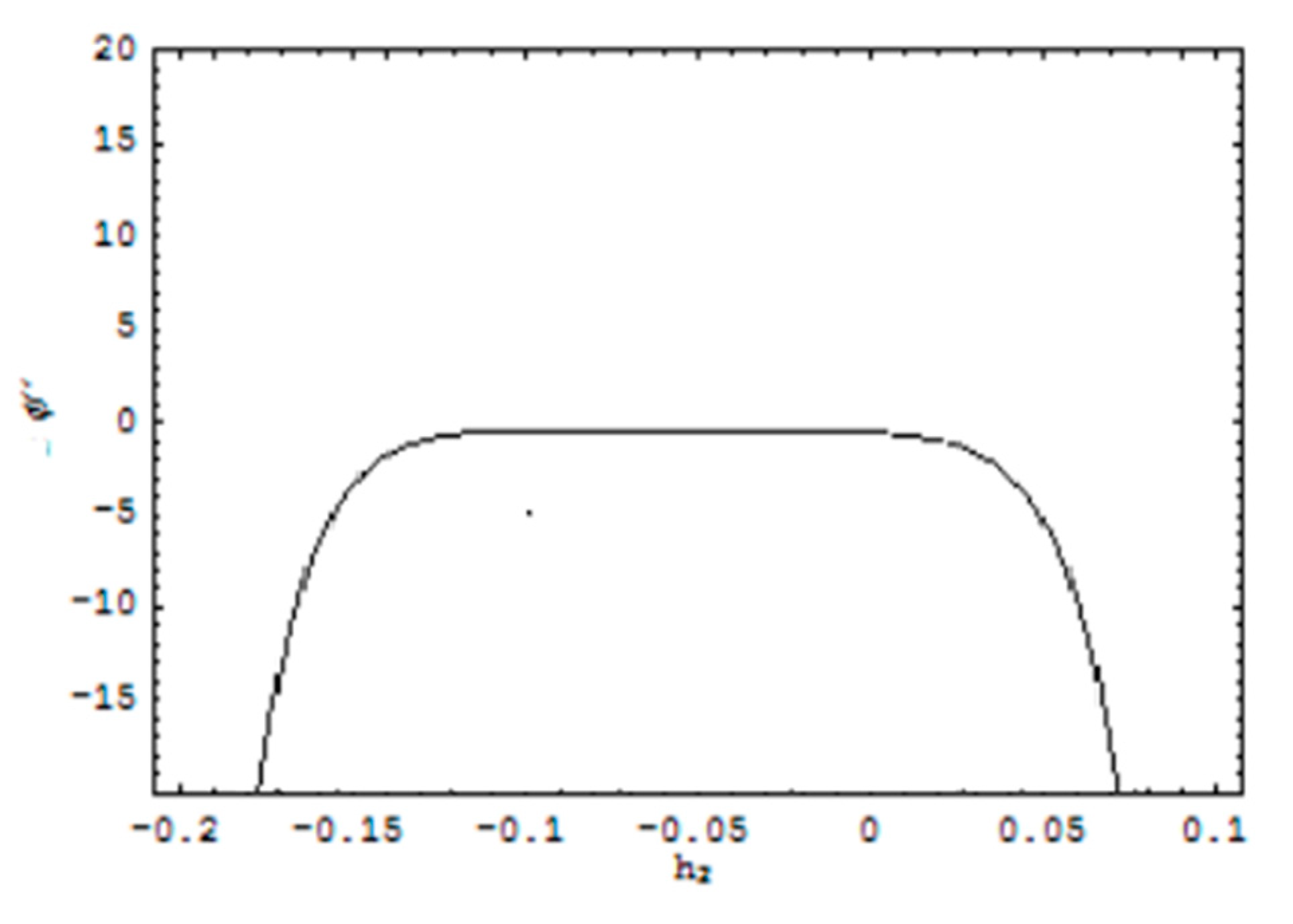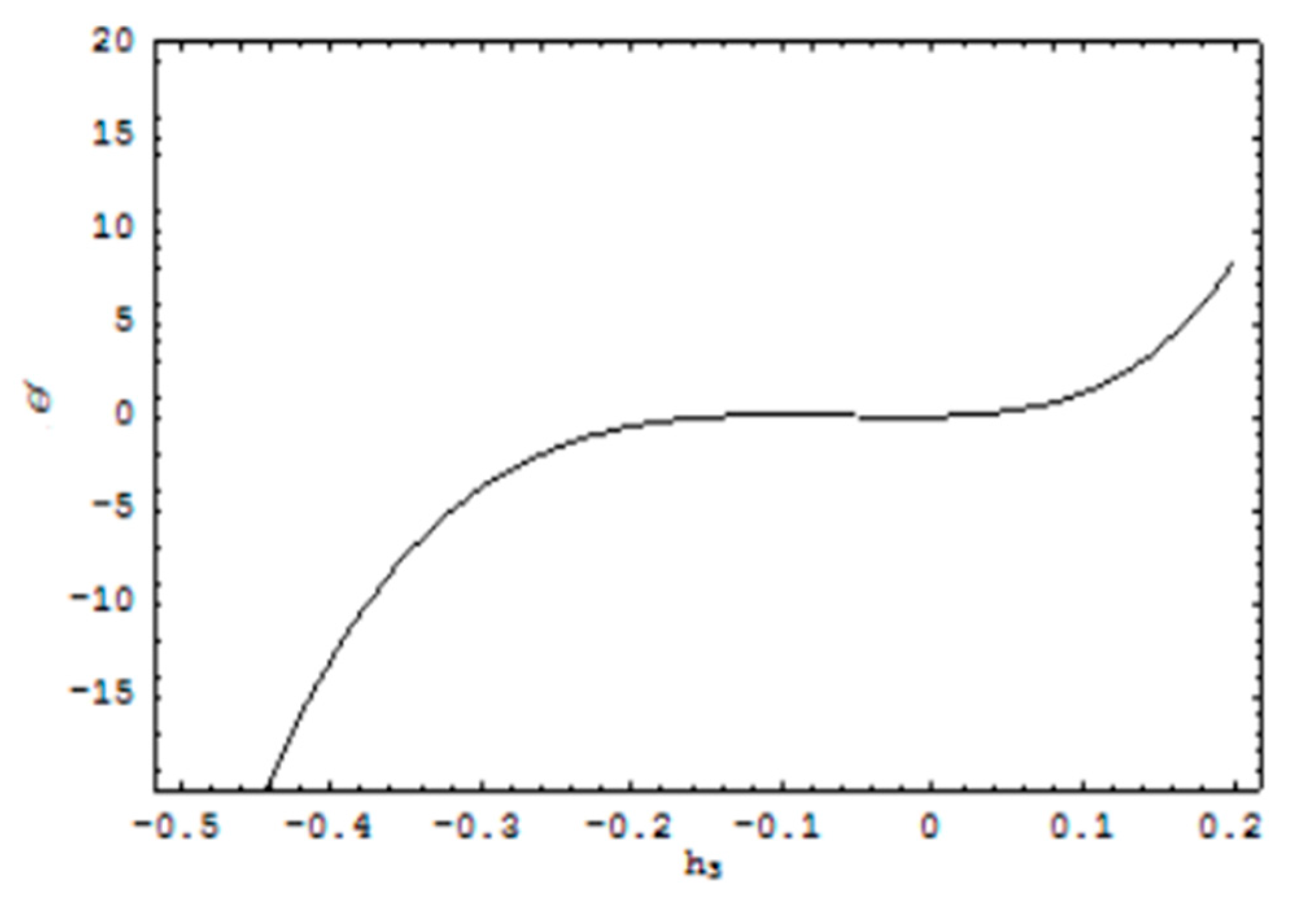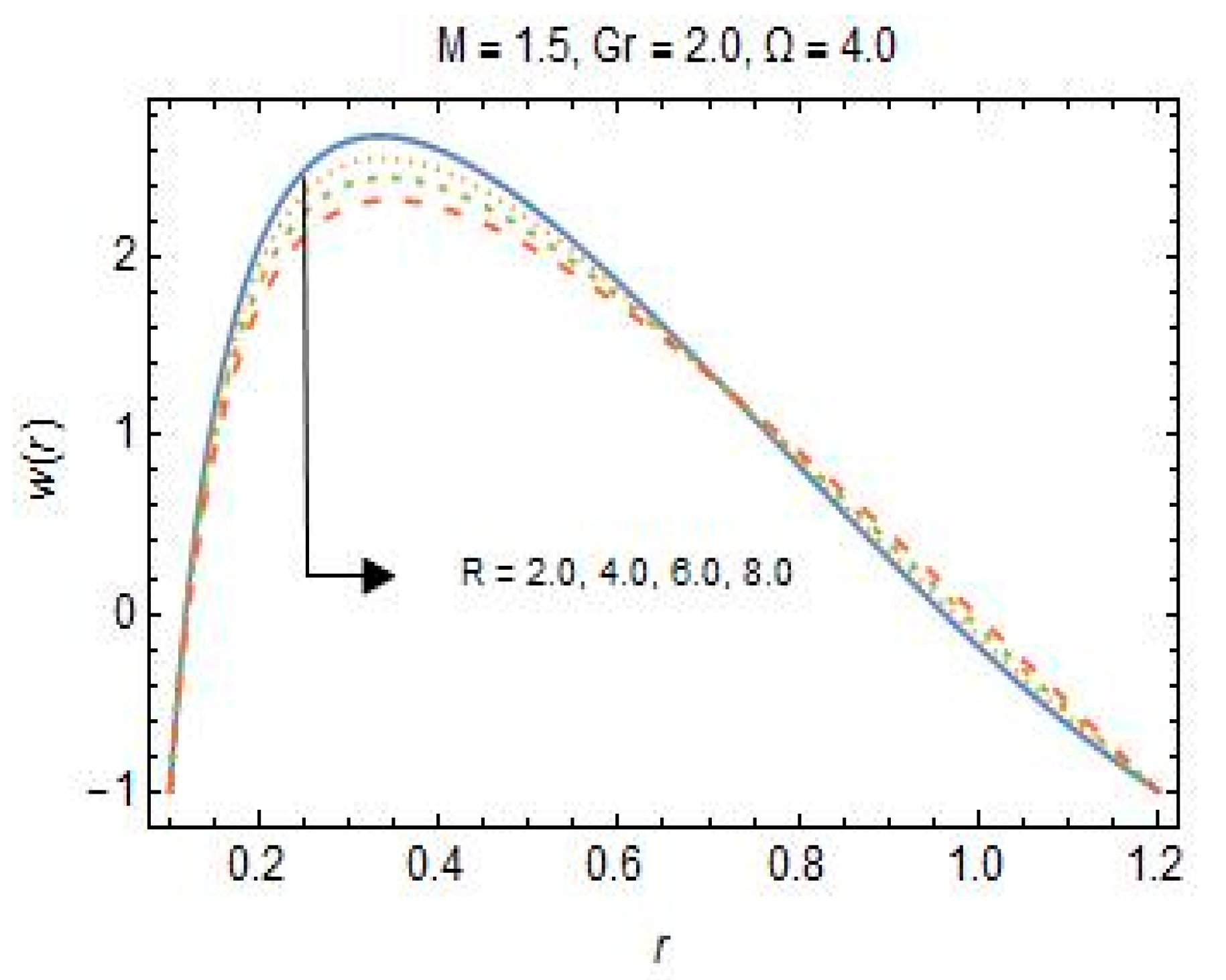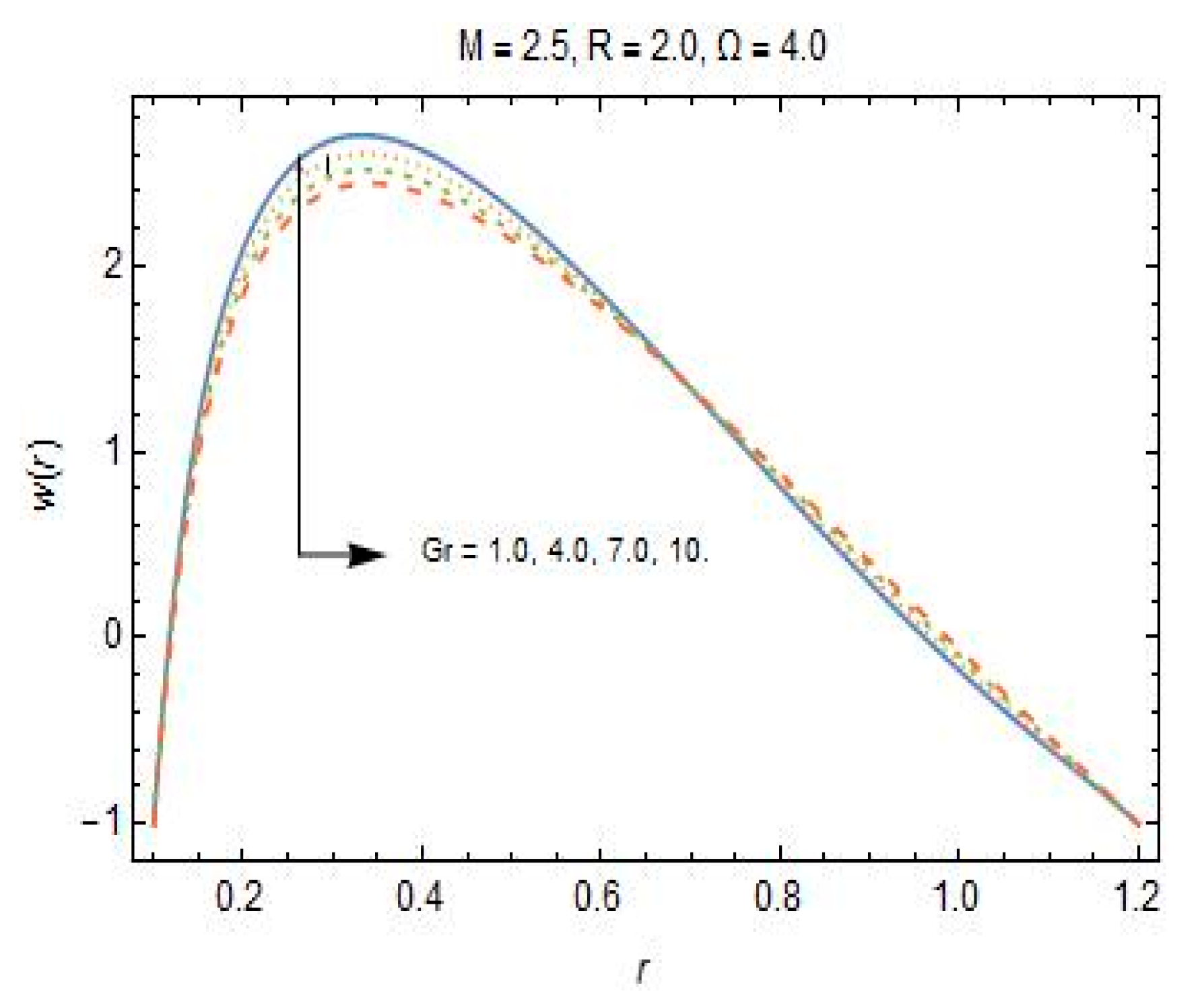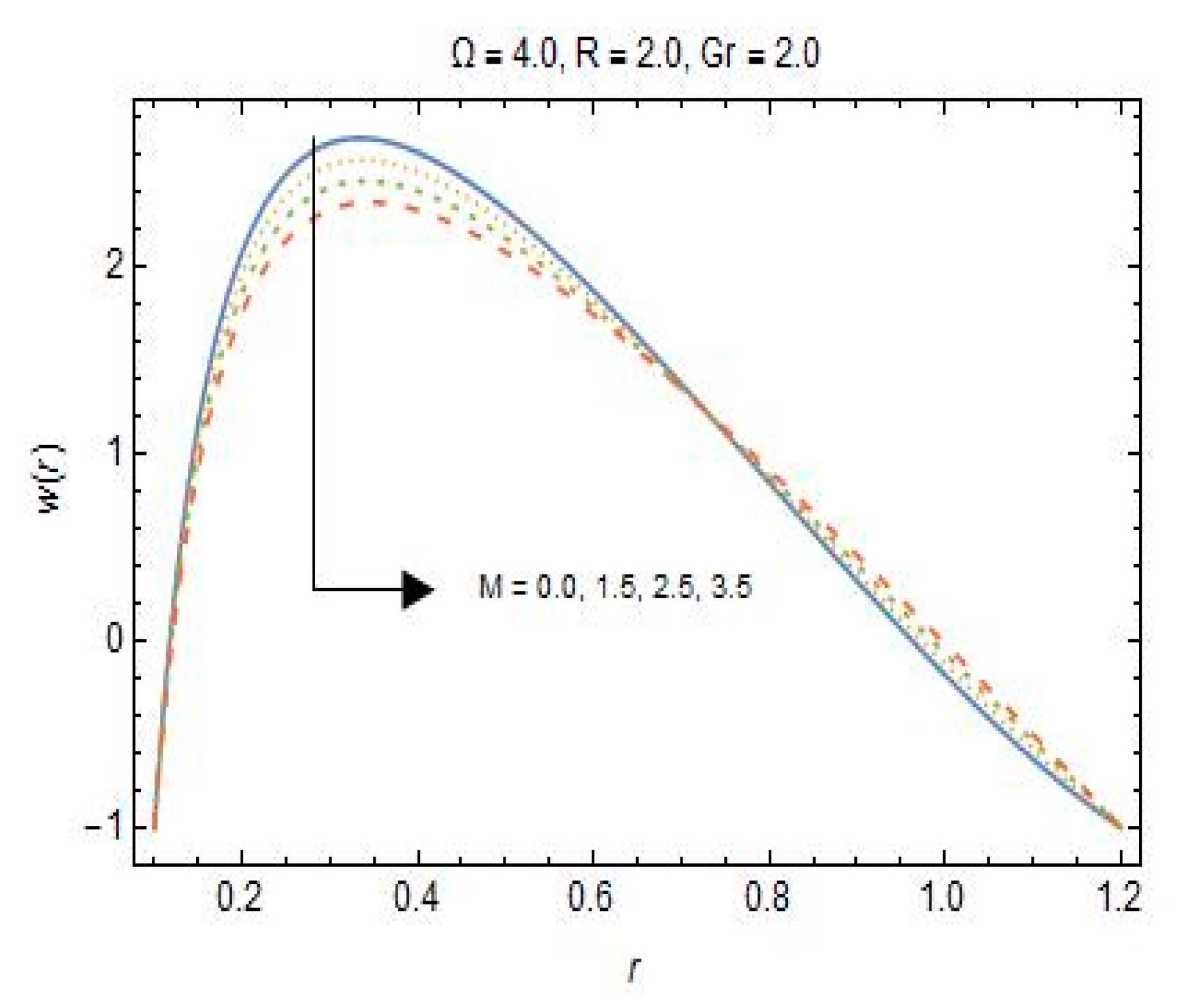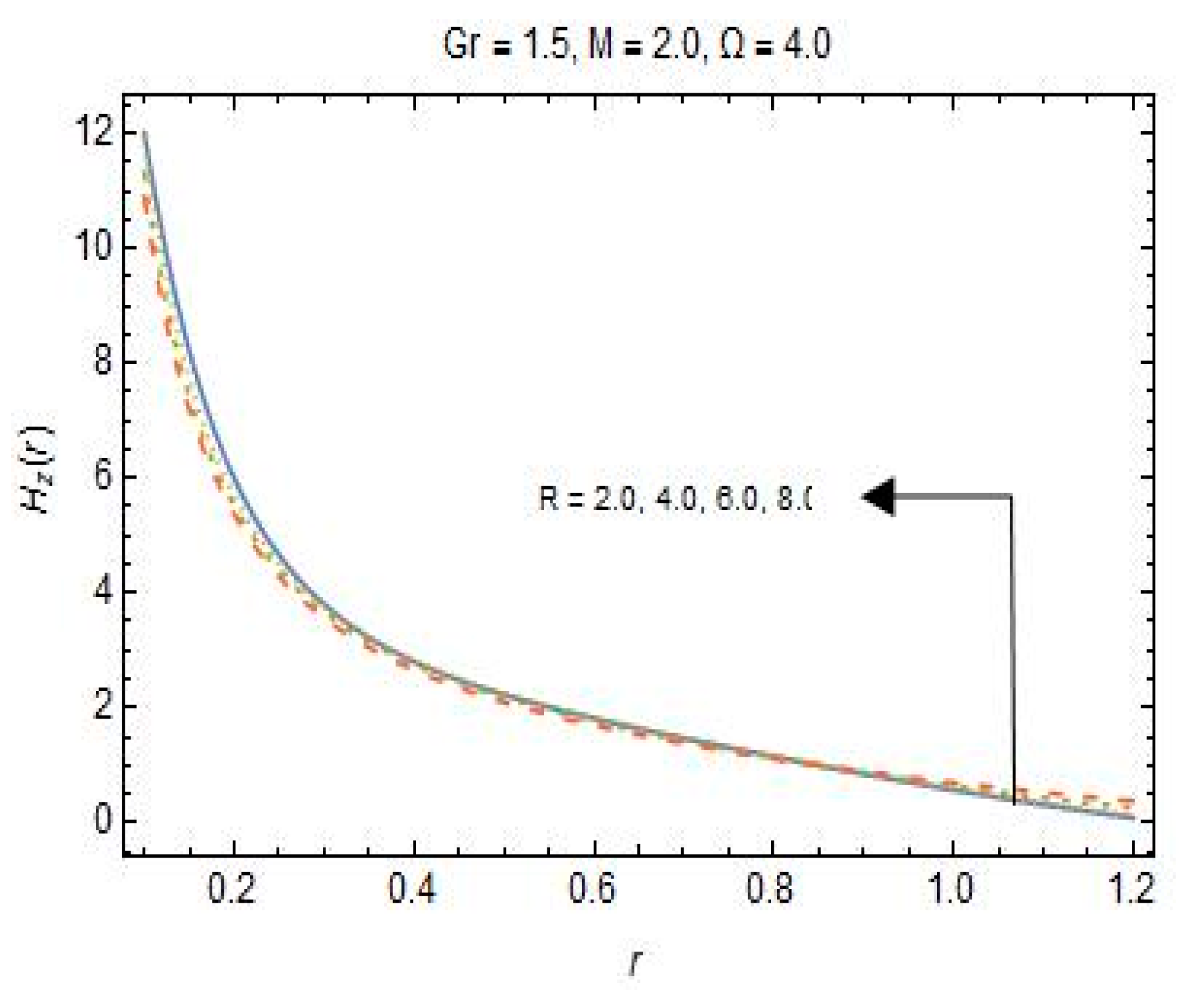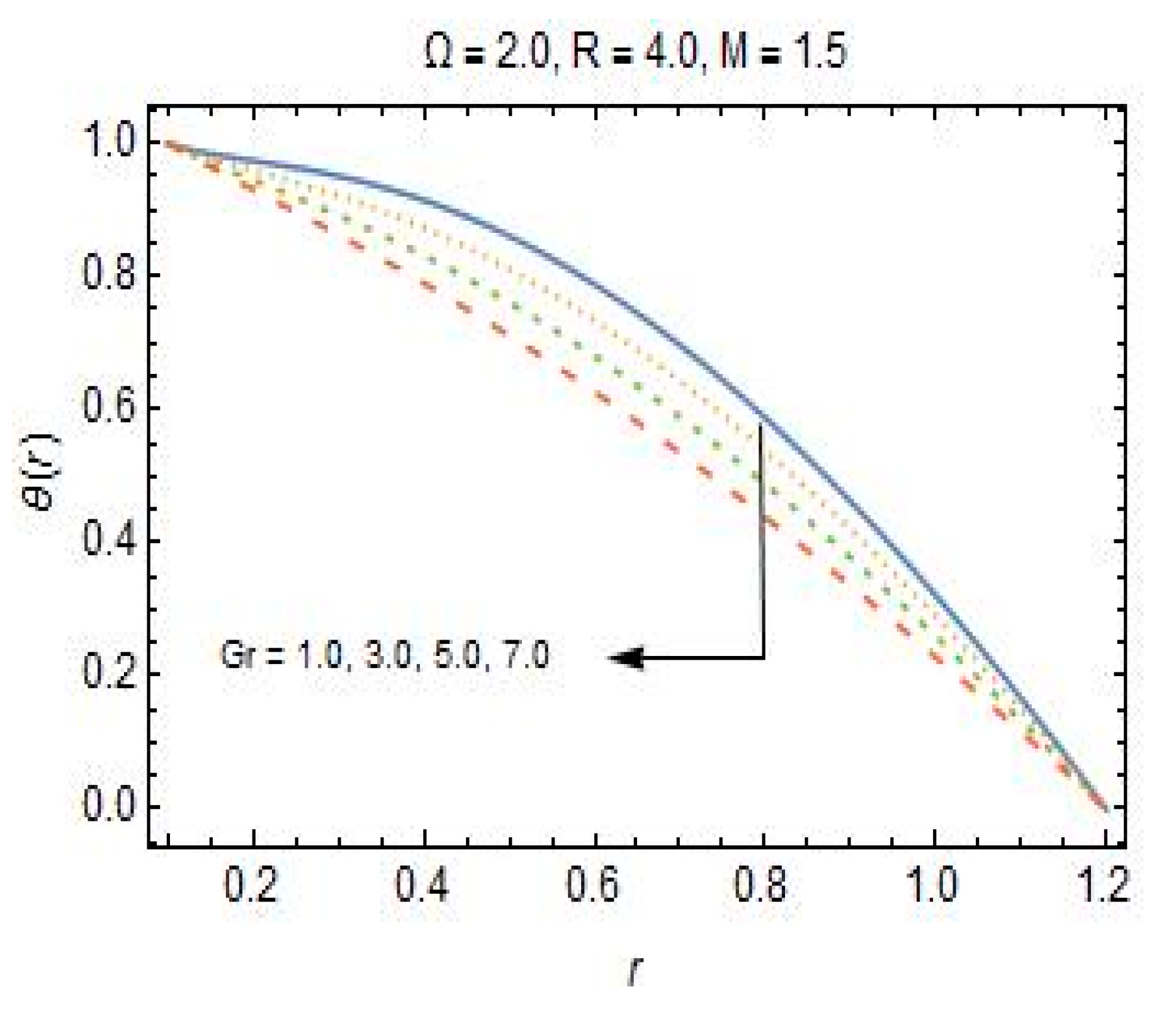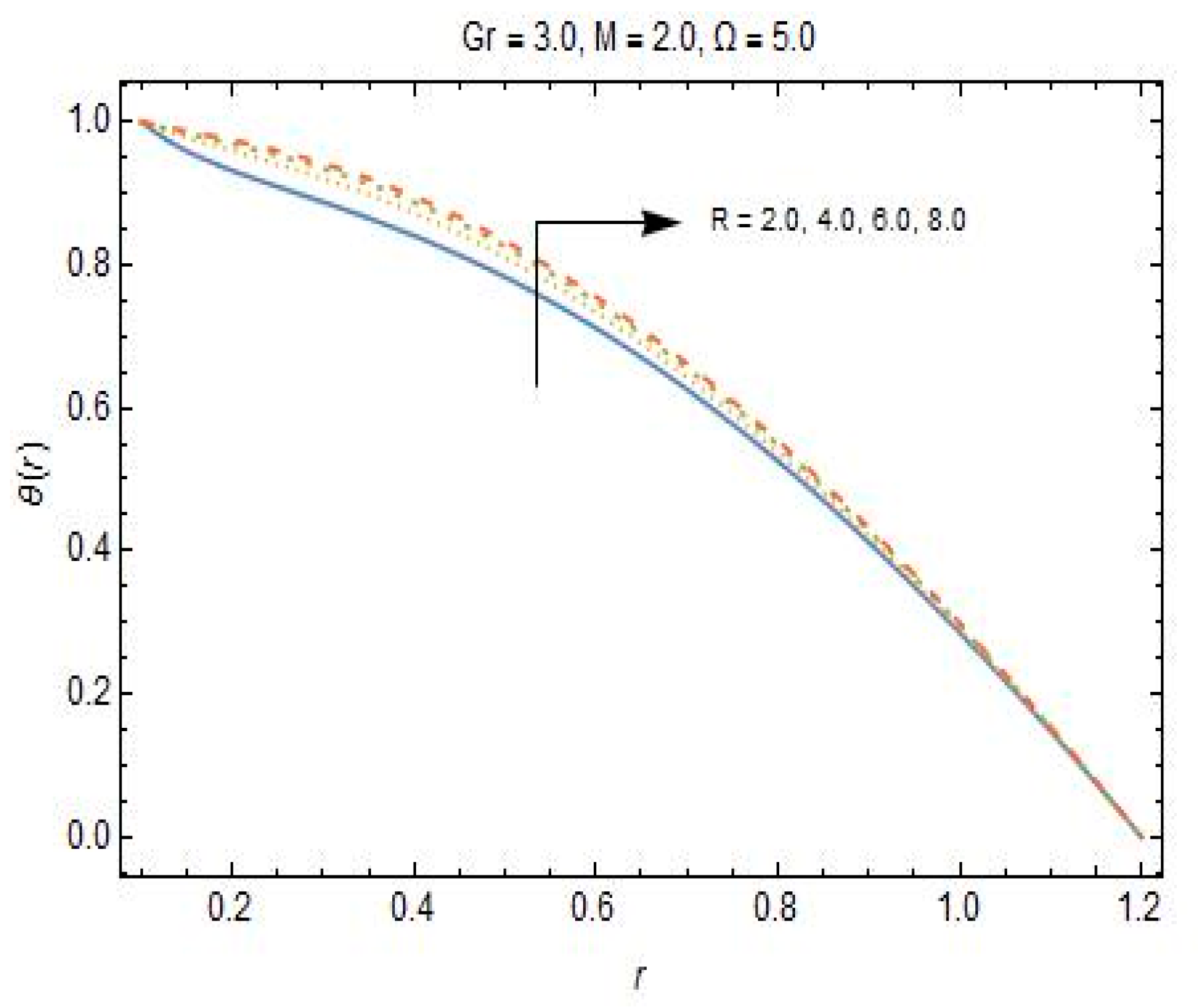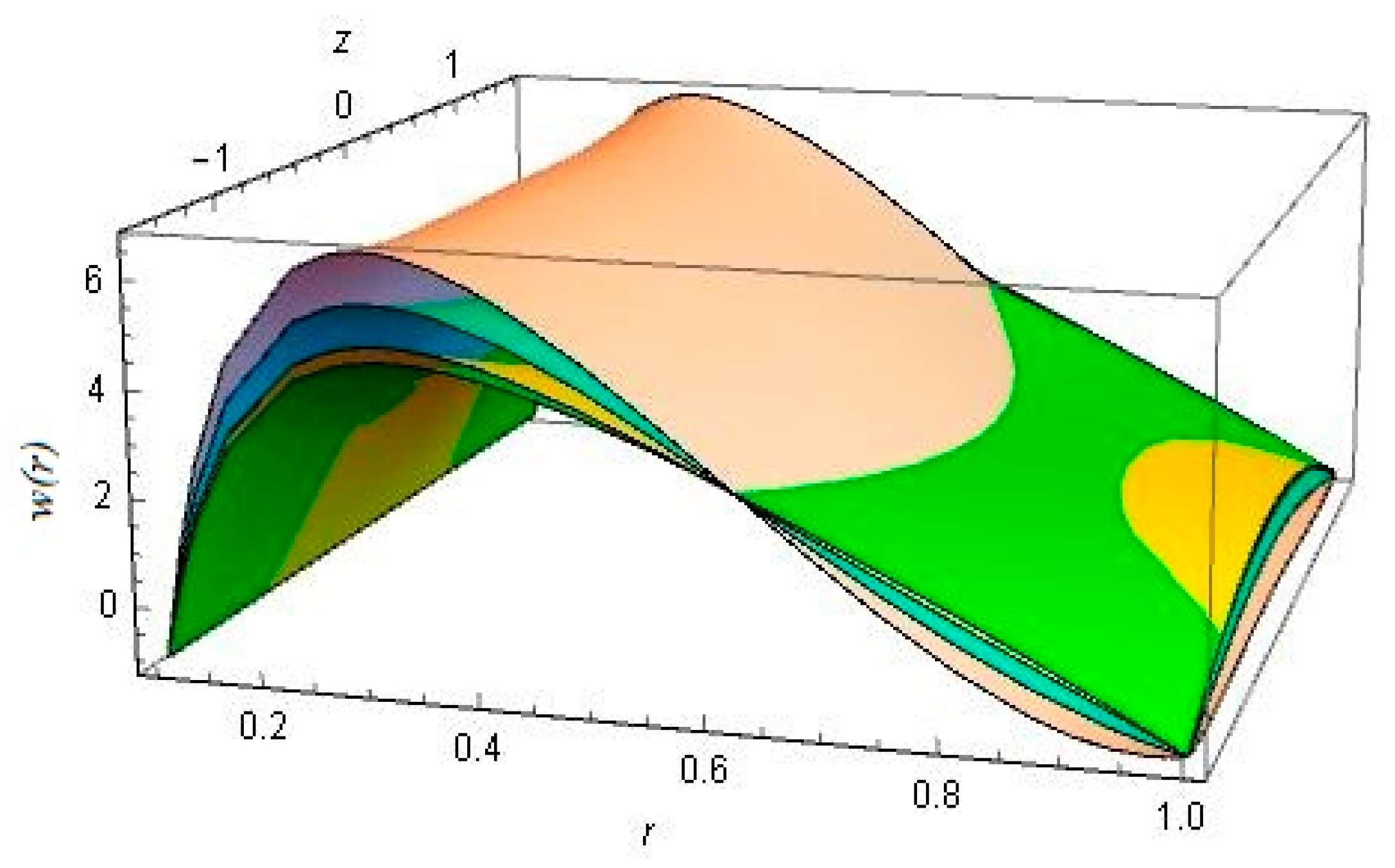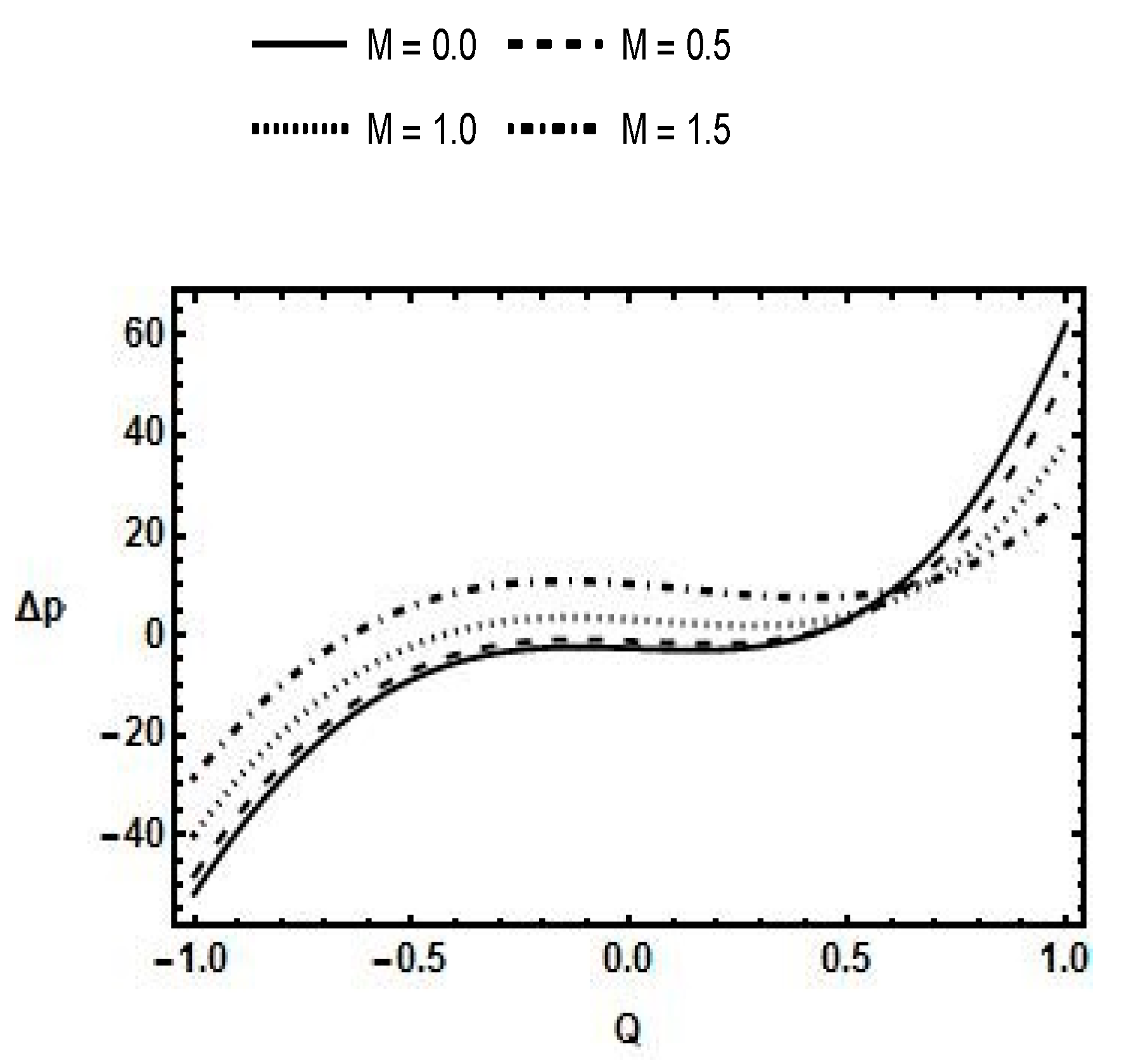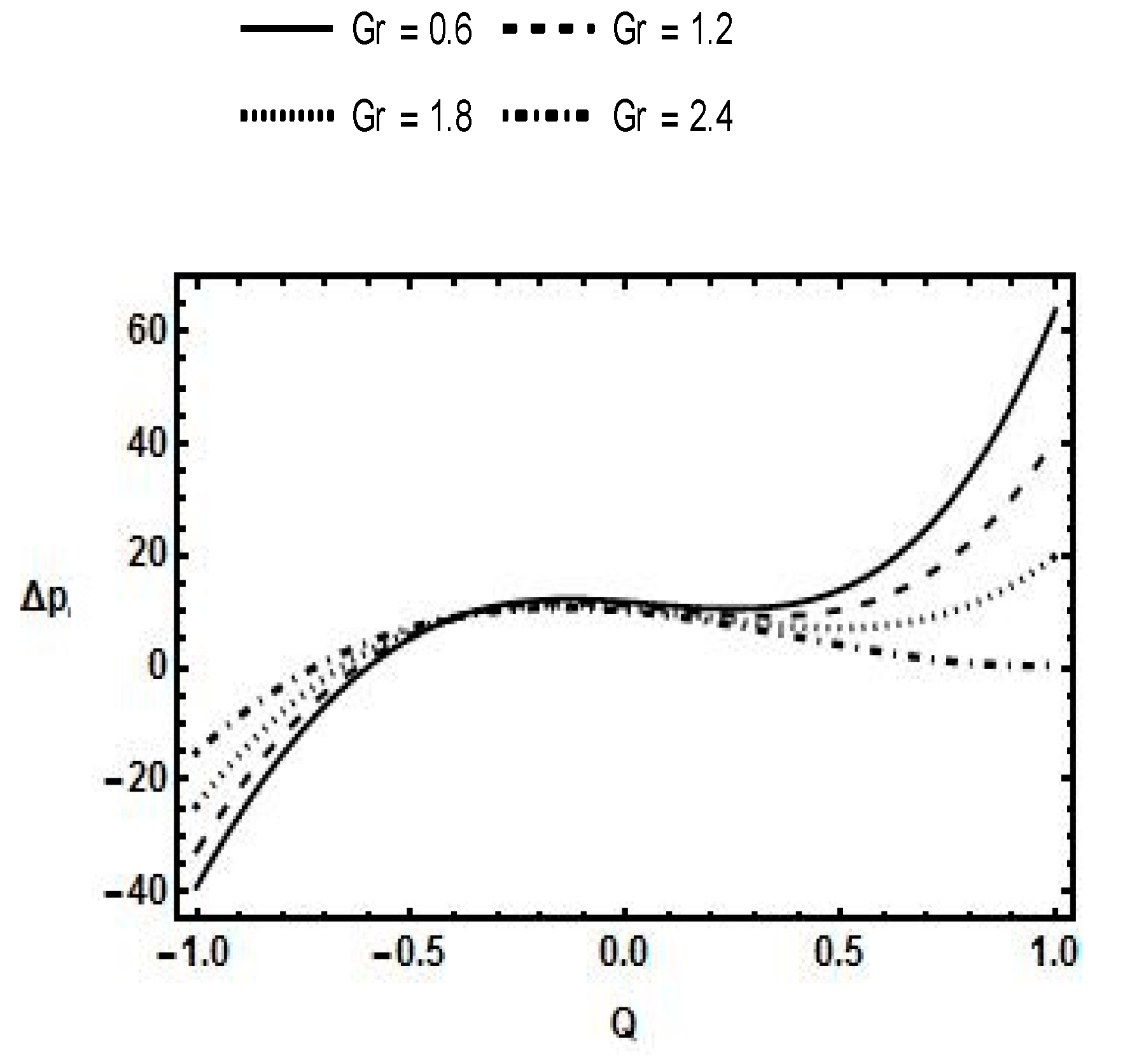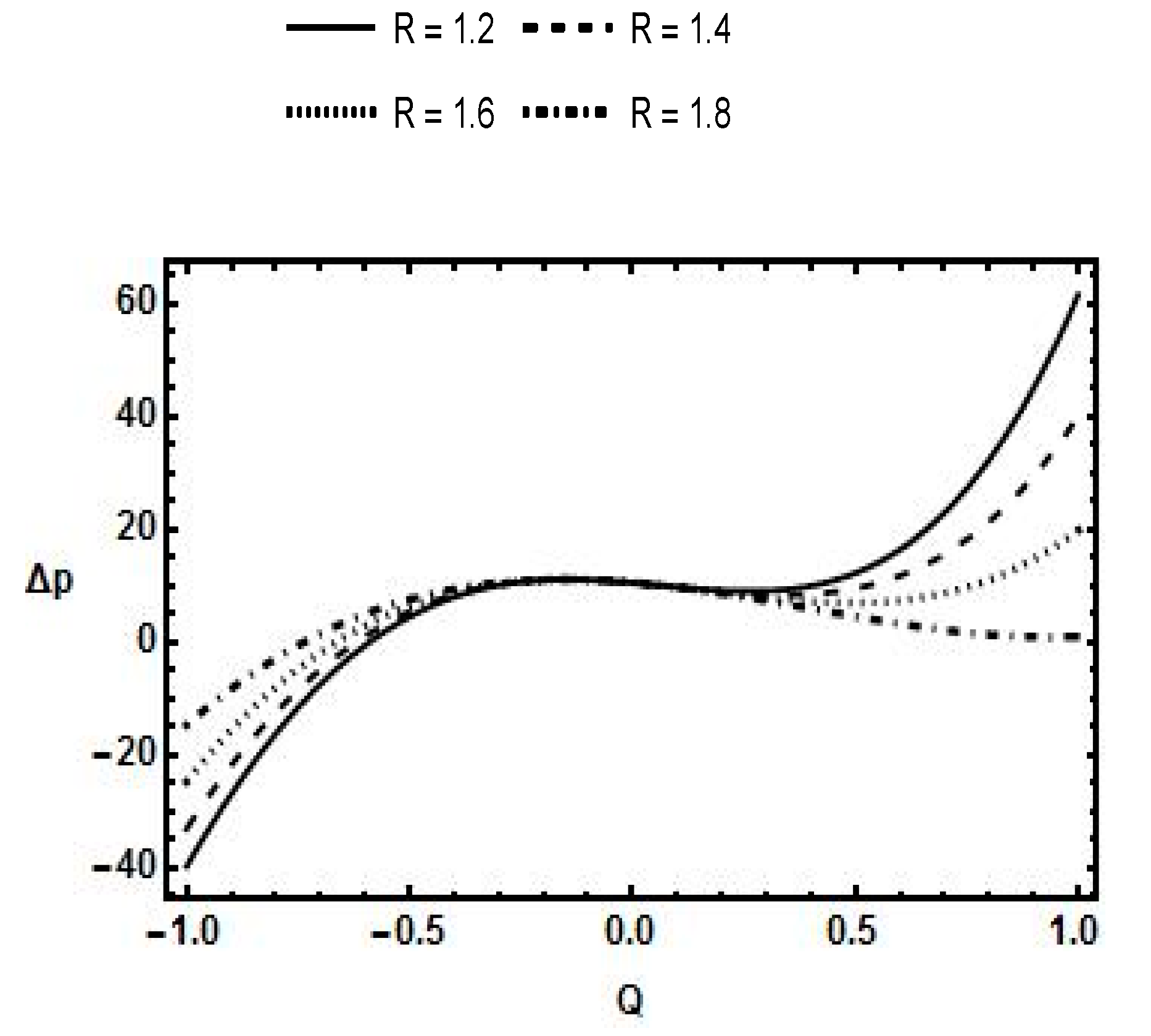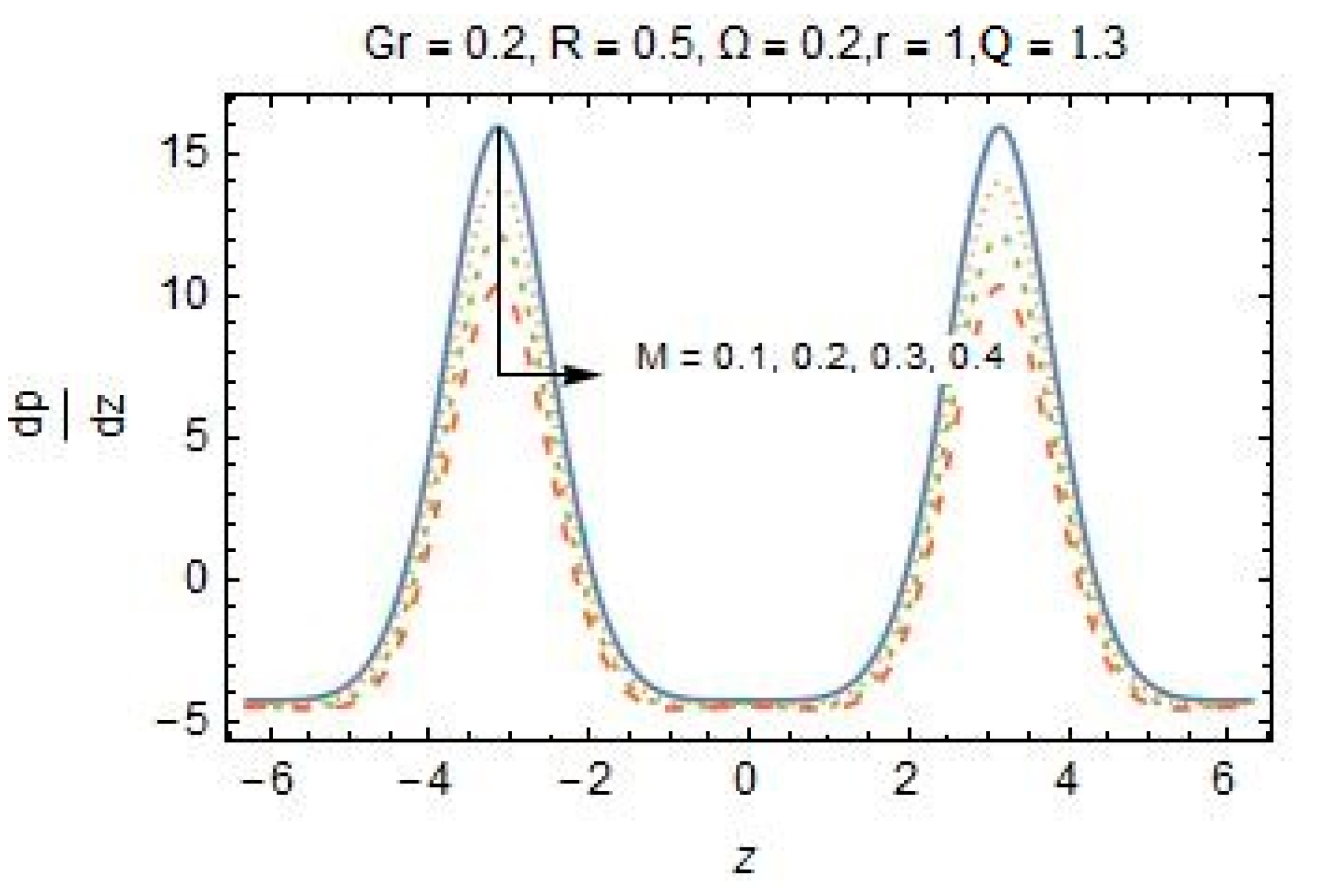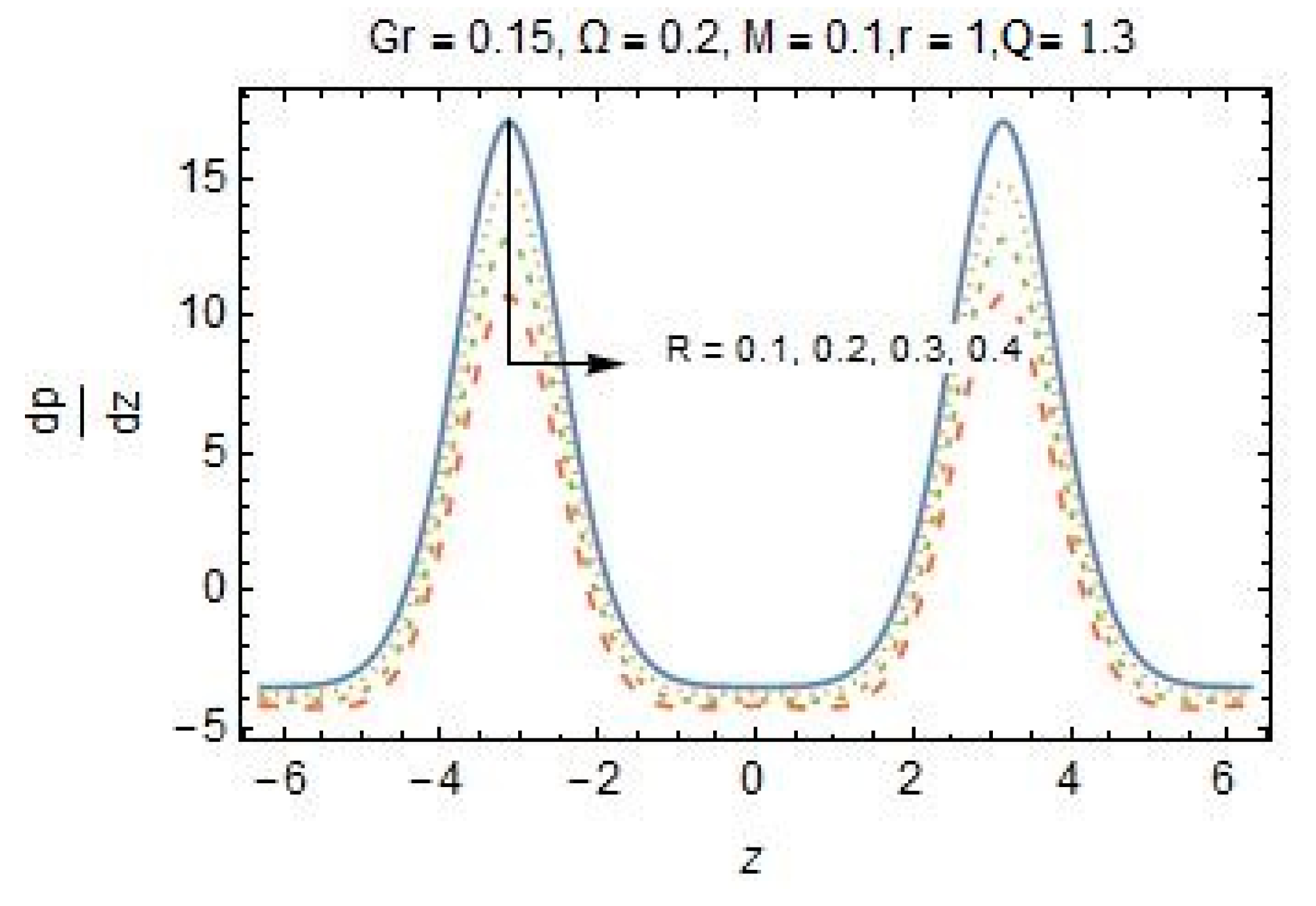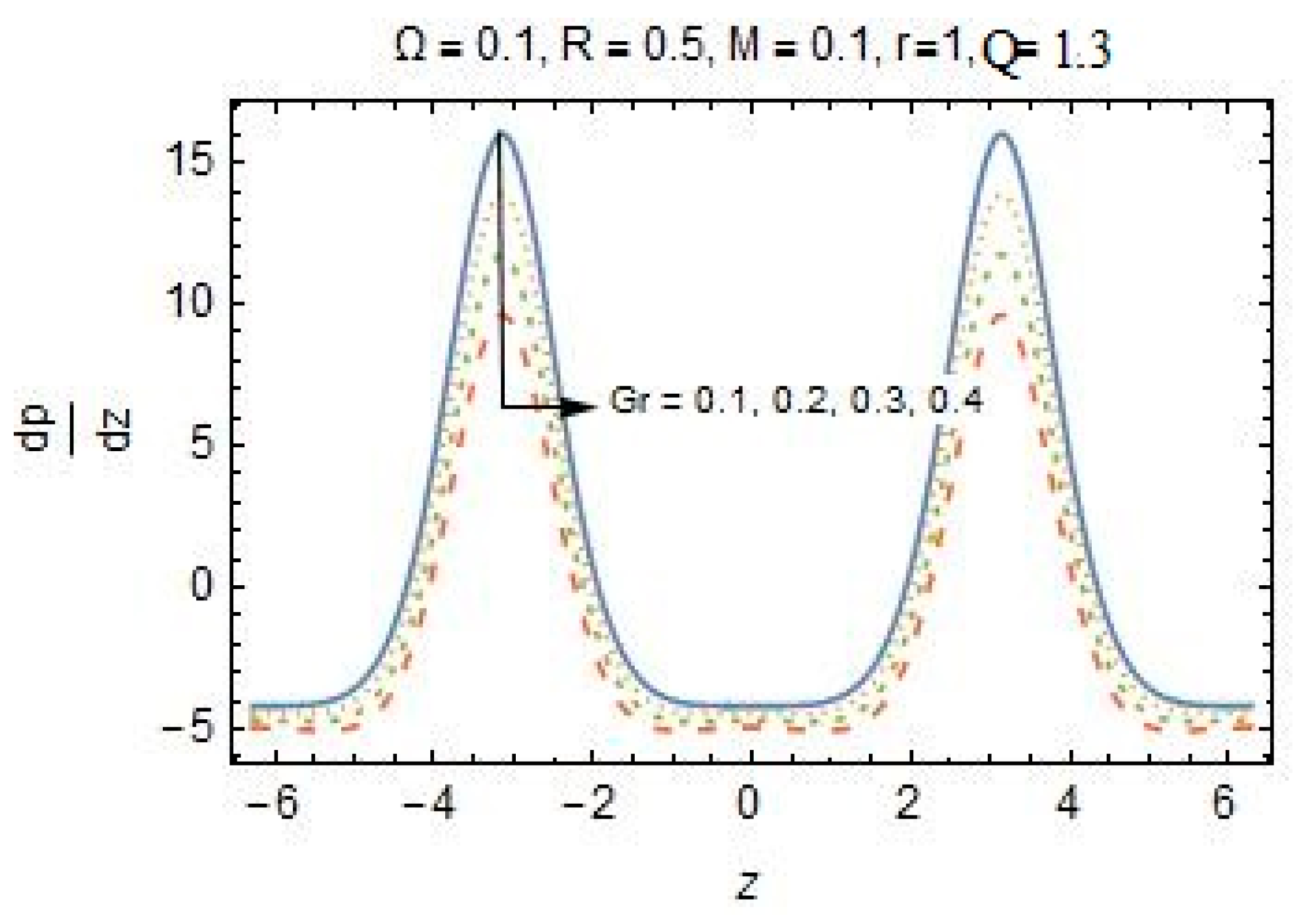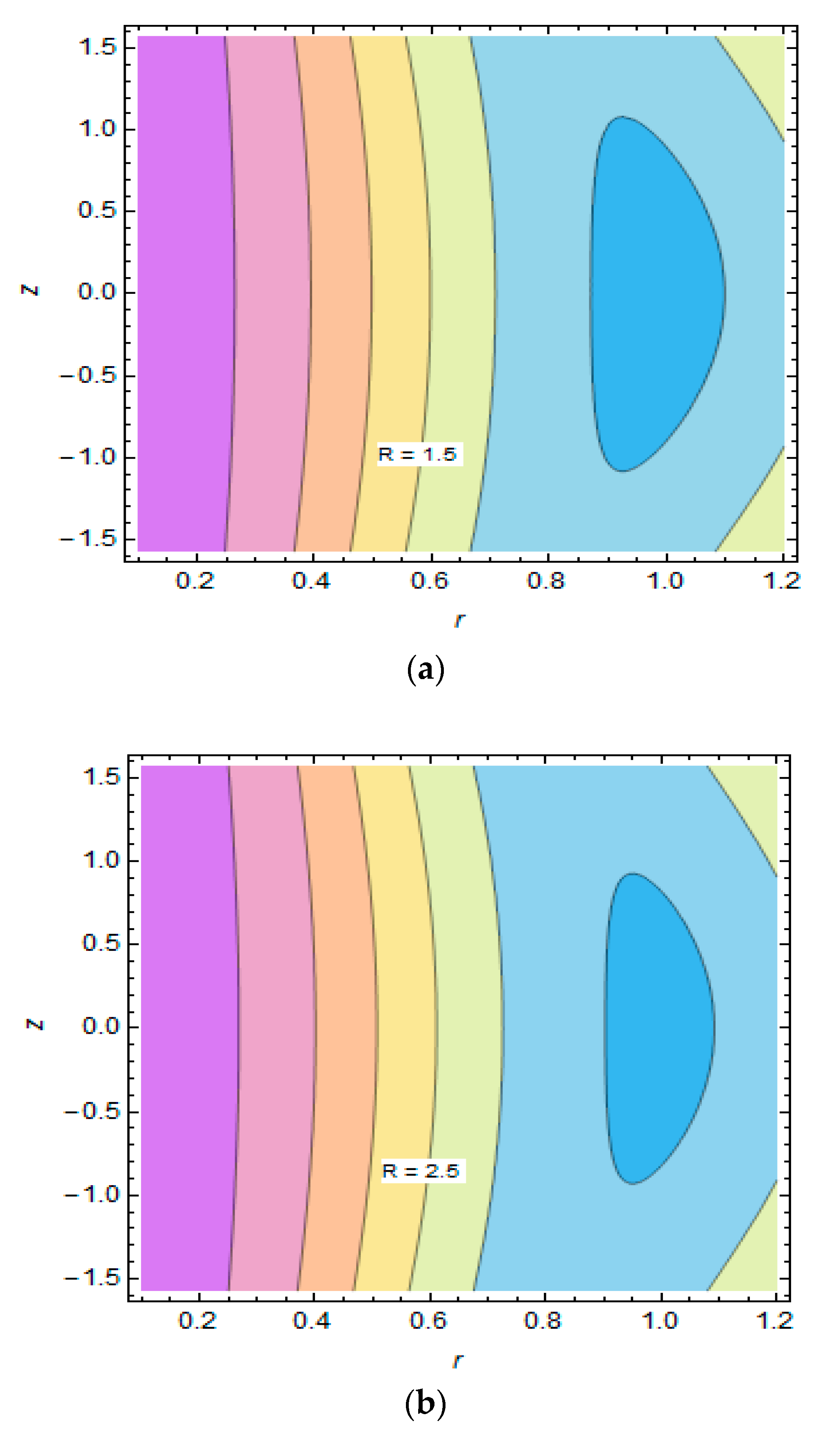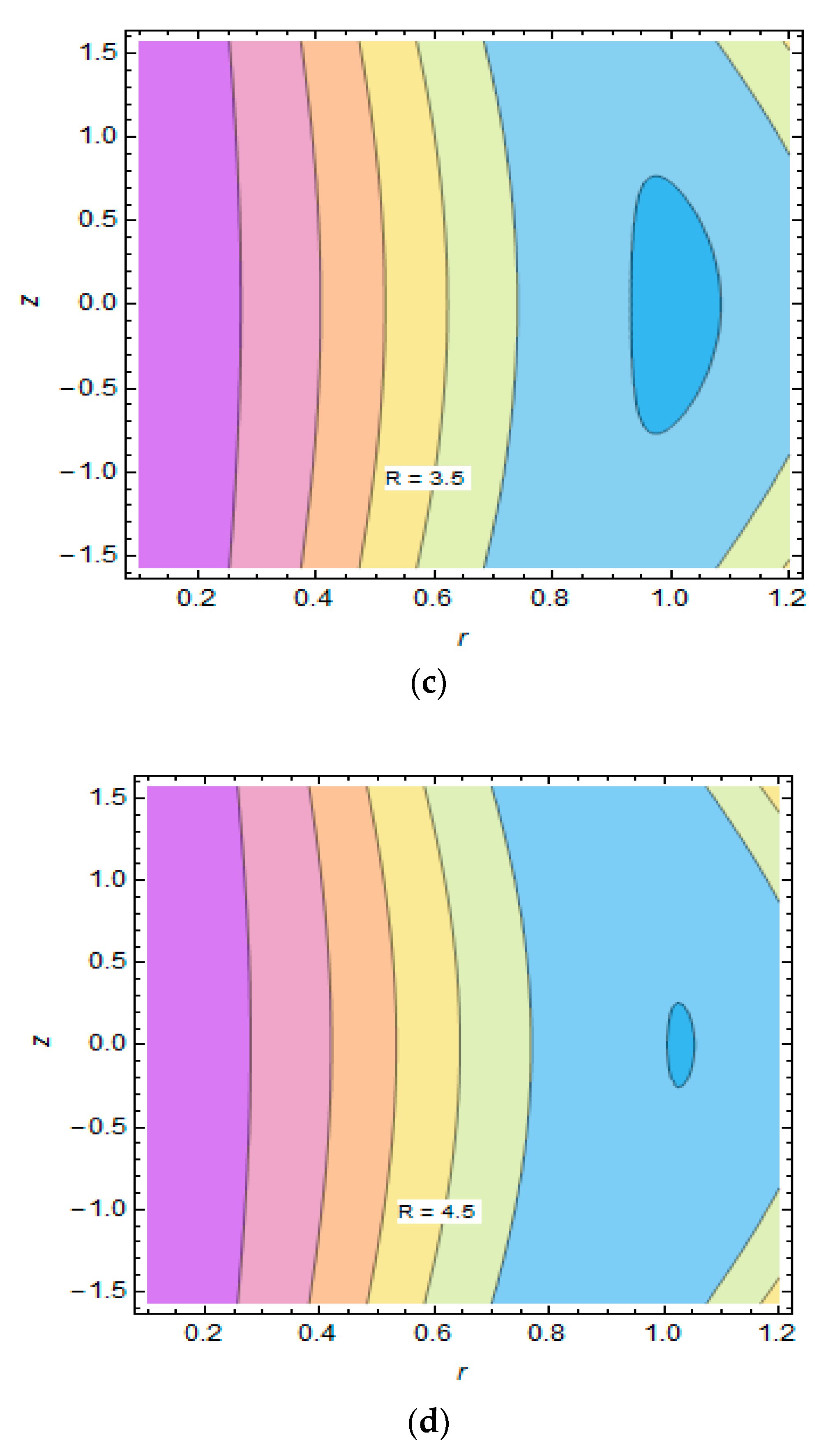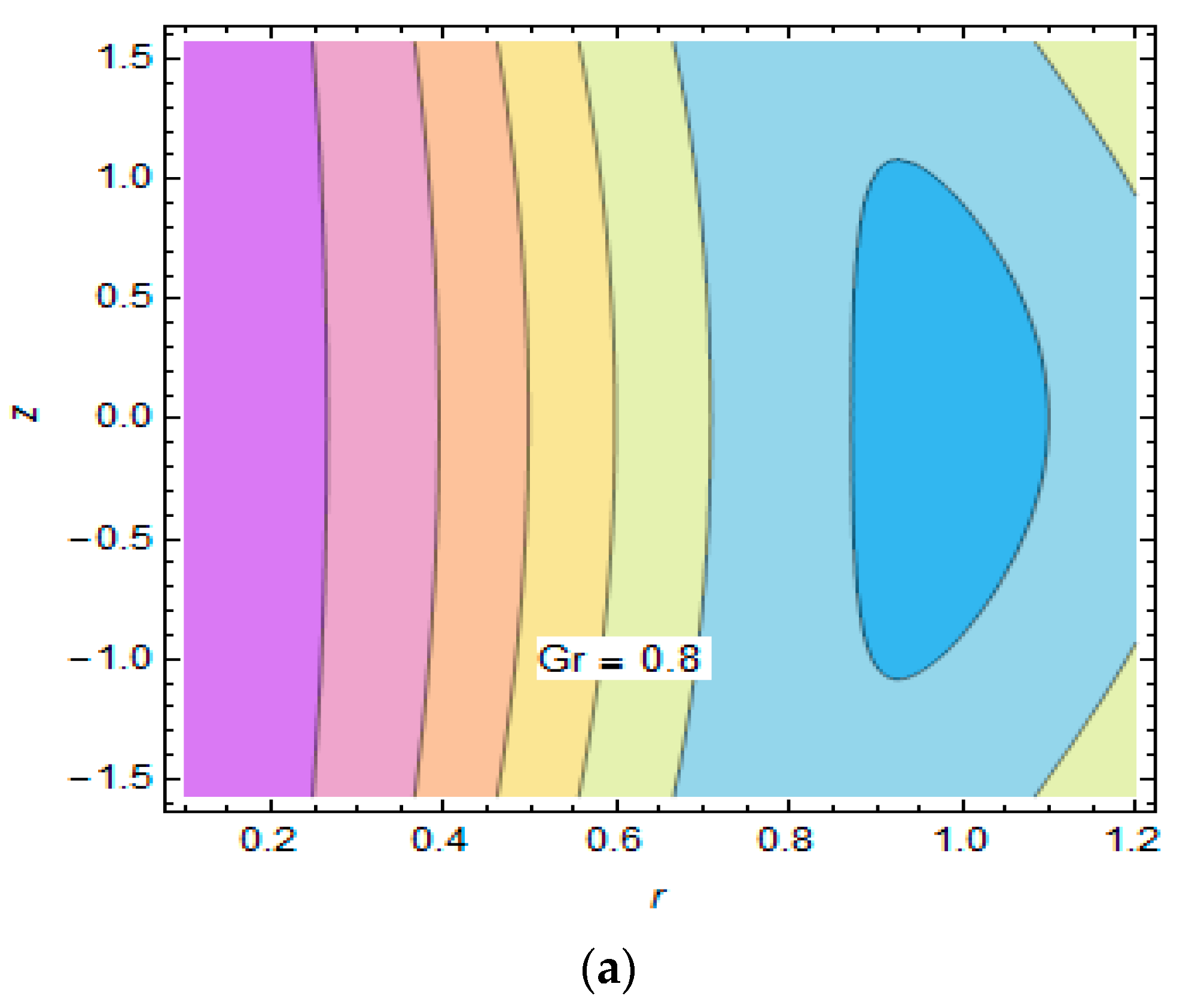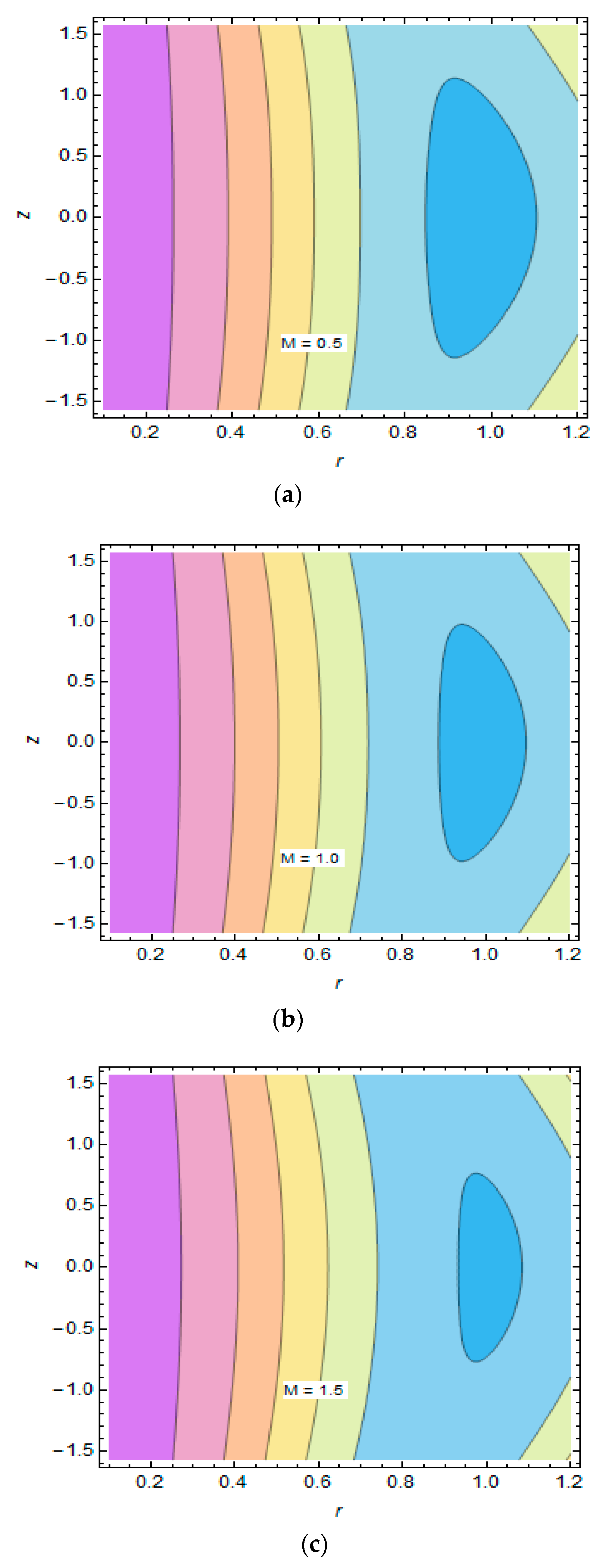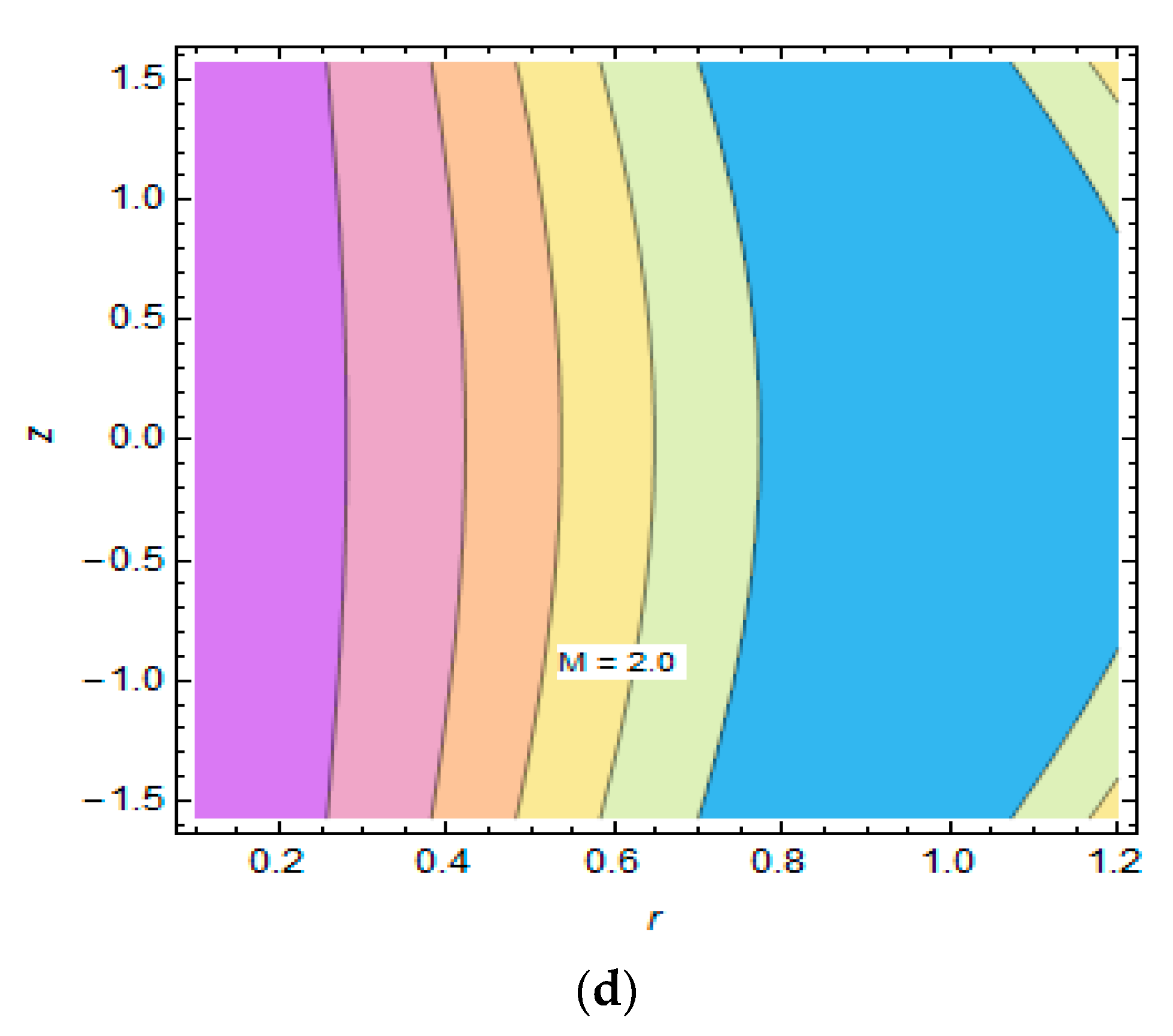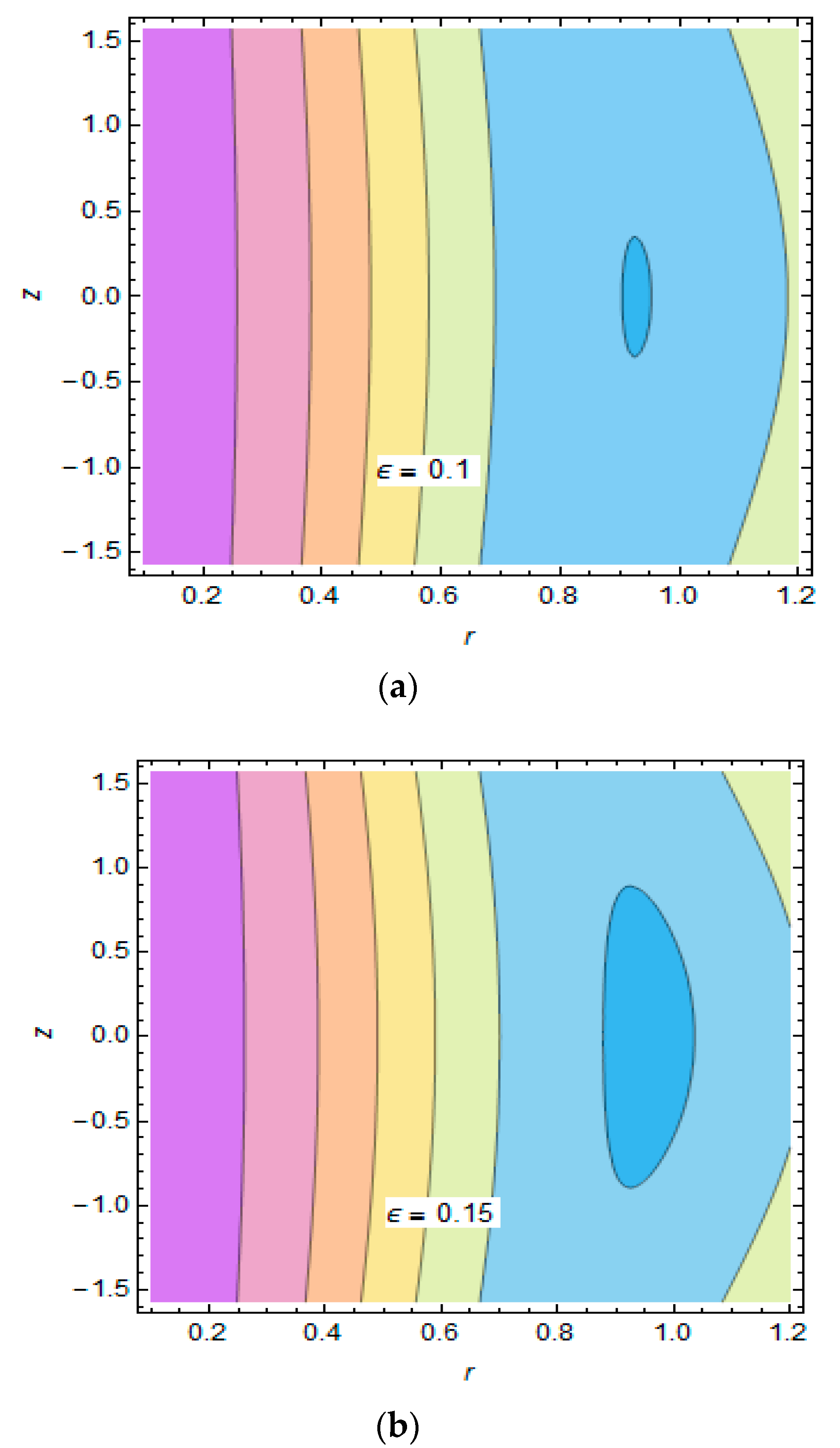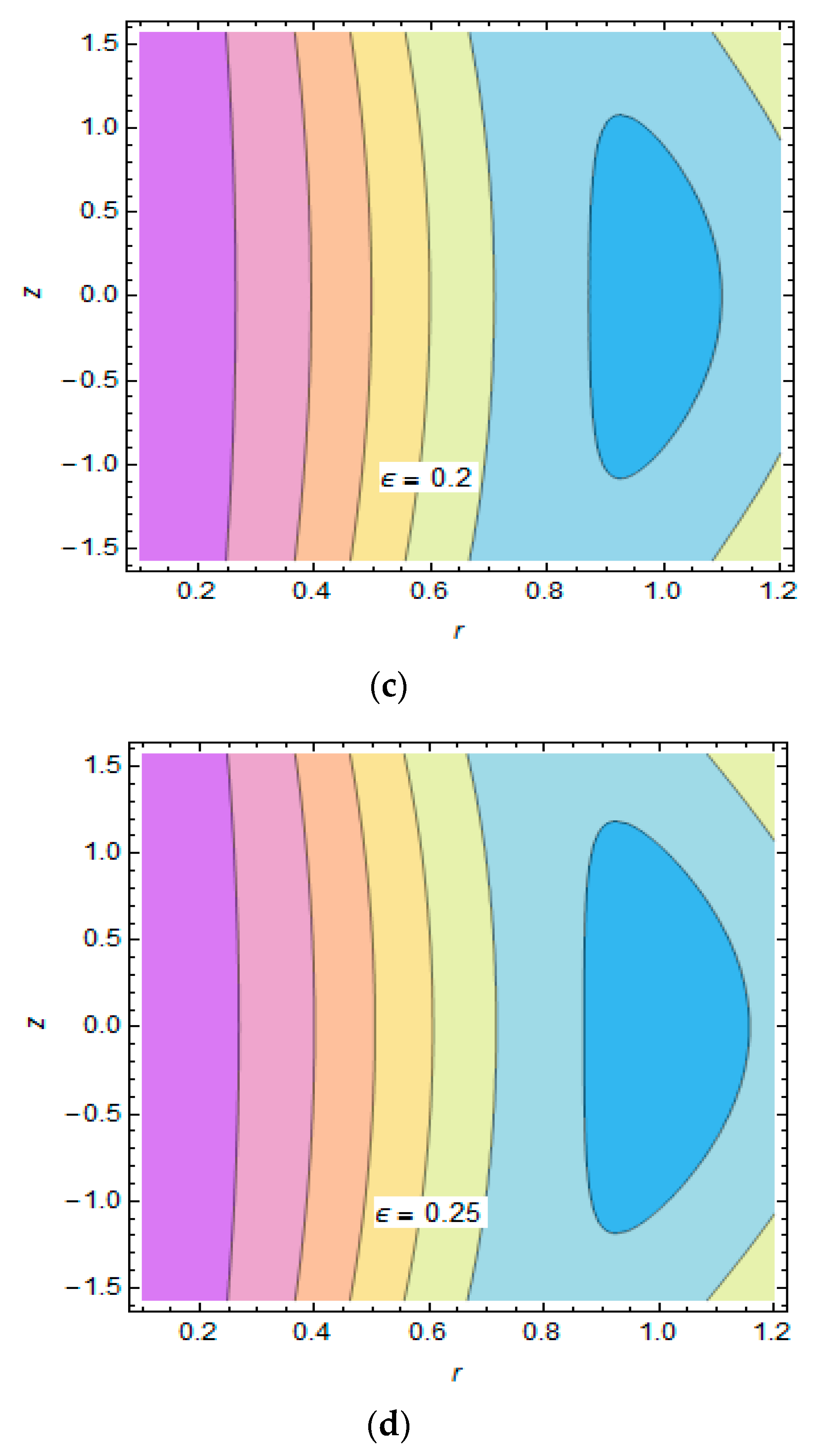1. Introduction
Fluids possess a significant role in the amplification of heat exchange rate in numerous engineering systems, e.g., heat exchangers, oil and petrochemical industries. Nanoparticle suspensions, pioneered by Choi [
1], made thermal performance of these fluids more effective and it has become a topic of interest for many investigators [
2,
3,
4,
5]. Regardless of researchers’ efforts, there has been an elementary issue with mono nanofluids that either they possess better thermal association or good rheological characteristics. For example, metal oxides such as Al
2O
3 show excellent chemical inertness as well as stability, whereas metallic nanoparticles including Al and Ag exhibit better thermal conductivities. Most of the authentic applications required transaction between different properties of nanofluids and thus hybridization of nanomaterials has been introduced. Hybrid nanofluids can be manufactured by dispersing nanoparticles of different materials individually or a mixture of nanoparticles in base fluid. For instance, impacts of Cu–Ag nanohybrids on velocity and thermal boundary layer transport inside the wedge have been investigated by Hassan et al. [
6]. To gain the highest composite thermal conductivity, chemical inertness and stability by using a small-volume fraction of nanoparticles at lower production cost is the motivation of researchers behind their utilization of hybrid nanofluids [
7,
8,
9,
10]. Moreover, nanoparticles of TiO
2 exhibit antibacterial and photocatalytic properties. Nguyen et al. [
11] has studied antibacterial properties of TiO
2 by adopting silver decorative technique and revealed that oxide nanoparticles of titanium did not show inhibitory impacts for bacteria whereas silver loaded TiO
2 nanocomposites display efficient antibacterial characteristics at a concentration of 40 mg/mL. Ag nanoparticles are able to devastate pathogenic bacteria under ultraviolet radiation for efficient degradation of toxic pollutants as well as being easy to attach to cell membranes [
12,
13,
14]. Therefore, Ag–TiO
2 nanocomposite is preferred in this theoretical inspection. Moreover, platelet-shaped particles are chosen since they capacitate swift healing in skin injuries because of their innate capability to make a boundary intended for vascular walls.
A cilium is a microscopic, contractile, thin fiber-like slender appendage/protrusion that projects from surfaces of specific cells. In the adult human body, epithelial cells along with motile cilia are very prominent in specific brain sections. Due to their motility, they possess a considerable role in many physiological processes like locomotion, alimentation and respiration. Peristalsis is a spontaneous process of a symmetrical wave’s expansion and contraction within flexible boundaries. Ciliary-induced peristalsis appears significantly in various biological transport processes such as in biomedicine, physiology and nuclear reactors. Recently, Awais et al. [
15] examined second-law analysis for peristaltic nanofluid flow caused by ciliary action with magnetic effects. Furthermore, they studied convective peristalsis of viscous fluid by considering non-uniform viscosity [
16] as well. Furthermore, the concept of peristaltic pumps, instigated by Engelman [
17], has latterly been prominent in several biological functions including roller pumps and heart-lung machines etc. As peristalsis is a cutting-edge field due to physiological applications, several theoretical as well as experimental attempts have been made to incorporate nanoparticles in order to improve thermal performance in biomedical processes. Rashidi et al. [
18] exemplified the application of MHD peristaltic transport of blood containing nanoparticles in drug delivery through an incompatible channel which is practically imperative in the bio-sciences. Hayat et al. [
19] explicated mixed convective heat transfer in the peristalsis of nanoparticles suspended in water assuming convective boundary conditions and joule heating. Recently, Maqbool et al. [
20] inspected the impacts of nanoparticles on magnetohydrodynamic tangent hyperbolic fluid transportation in a ciliated tube.
Attention to non-Newtonian fluids arises as the majority of the physiological fluids possess non-Newtonian behavior verified by experimental observations. In view of the fact that simplified Newtonian models yield somewhat ambiguous results, several investigations on rheological fluid behaviors have been carried out to obtain more realistic results. Examples include inelastic fluid models e.g., the power-law model and viscoelastic fluid models such as the Johnson–Segalman model, Oldroyd-B model and Maxwell model. Mixed convection impacts towards peristaltic transport of magnetohydrodynamic non-Newtonian nanofluid were numerically evaluated by Hayat et al. [
21]. The current study examines the rheological nature of fluid by employing Ostwald-de-Waele power law model, a generalized one, in which rheological nature directly depends on power law index
n and deals with the shear thinning for (
n < 1) and shear thickening for (
n > 1) behaviors of fluid [
22,
23,
24,
25].
Moreover, the peristaltic flow with influences of applied magnetic field led to significant applications in biomedical engineering problems [
26,
27,
28]. In the case of large magnetic Reynolds number for an electrically conducting fluid, induction becomes more prominent than magnetic diffusion, and this made the induced magnetic field effects accountable. Shit et al. [
29] examined the influence of induced magnetic field on peristalsis of a micropolar fluid assuming velocity slip. They observed that peristaltic flow rate enlarges in an induced magnetic field which led to mechanical stimulation. So, magnetic induction is appropriate in cancer treatment and magneto therapy as predicted in literature [
30,
31,
32]. Besides this, the performance of coatings with magnetic nanoparticles and heat transport is ever-present in various fields. Magnetic nanoparticles, approved by the FDA (Food and Drug Administration) [
33], with coating are applicable in medical processes such as blood pressure control of a patient, pharmacotherapy, surgery and alcohol detoxification etc. Ellahi et al. [
34] carried out a comparative investigation on shiny film coating on multi-fluids dispersed by nanoparticles. Akbar and Butt [
35] inspected the physiological flow of Casson fluid through a plumb duct. They observed that fluid behaves as electrically conducting with a uniform magnetic field and found analytical results under small wave number and low-Reynolds number approximations. The recent related research can be read in [
36,
37,
38].
Furthermore, endoscopic imaging is a precious diagnostic instrumental locating persistent access to tissues deep inside hollow organs of the body. A conventional white-light endoscope is a solid circular cylinder placed in a peristaltic tube. Fluid flow occurs in the space between the tube and endoscope, and then further diagnostic procedures can be made such as for bleeding, cancerous growths and precancerous polyps. Hayat et al. [
39] have addressed the peristaltic transport of the MHD power law fluid with endoscope effects. Hayat and Ali [
40] have inspected the impact of an endoscope on peristaltically induced flow of micropolar fluid. The influences of non-uniform viscosity on peristaltic motion of Newtonian fluid through an endoscope have been conducted by Akbar and Nadeem [
41]. Rathod and Asha [
42] have investigated endoscope effects along with a magnetic field on peristalsis of the Newtonian fluid. They concluded that stress formation in a curved structure wall augments as compared to straight walls. In view of the significance of research regarding endoscopy applications, various studies have made (see refs. [
43,
44,
45,
46,
47,
48]).
With several advantages, advanced endoscopes are deficient in the spatial resolution for detection and treatment of cancers and abnormalities at small scales. Ciliary walls have importance since these biological cilia are helpful to perform complex biomimetic functions and applicable in vitro and in vivo synthetic organs as well as drug-delivery applications. In these unmet requirements, the effects of hybrid nanofluid and induced magnetic field on endoscopy application inside a ciliated peristaltic tube are addressed. Mathematical modeling is performed by considering negligible inertial forces and small wave number. An analytical solution of governing model is carried out by the homotopy analysis method, and results are plotted physically against several sundry parameters via tables and graphs. The trapping phenomenon is examined with the effects of electromagnetic induction as well.
2. Problem Description
A non-linear problem, concerning the transport and heat-transfer characteristics of non-Newtonian (Ag-TiO
2/H
2O) hybrid nanofluid in an endoscope due to ciliary metachronical rhythm is investigated here. A cylindrical coordinate system is used with
as position coordinates of fluid particles. Non-Newtonian behavior of the flow is considered with Ostwald-de-Waele power law model expressed as [
22,
25]:
where,
In above expression k and n respectively represents flow consistency index and power law index. In this study, non-Newtonian shear thickening fluid is considered with n = 2. Moreover, a constant magnetic field having intensity H0 is taken in radial direction causes an induced magnetic field and, thereby, total magnetic field vector is .
The governing system of equations in an unsteady form is [
25,
29,
30]:
where,
Wave shapes in the laboratory frame for envelope of cilia tips according to
Figure 1 can be expressed as:
where,
α1 and
α2 represents radii of internal and external cylindrical tubes, accordingly. Considering the motion of cilia in an elliptical path, the vertical position of cilia tips is expressed as:
Since the velocities of the fluid layers are similar to those of the cilia tips under the no-slip wall conditions, the vertical and horizontal velocities are:
With the help of Equations (10) and (11), Equation (12) becomes:
The associated boundary conditions are defined as:
If (R, Z, U, W) and (r, z, u, w) are, respectively, the coordinates and velocities in the laboratory and wave frame, then transformations from the laboratory frame to wave frame for a steady problem are [
48]:
We introduce the following dimensionless quantities in the wave frame as [
29,
31]:
A non-dimensional governing model for the aforementioned quantities along with long wavelength and creeping Stokesian flow approach is:
Equation (17) is simplified in the form:
where, bar notation is ignored.
Corresponding boundary conditions are listed as:
In the above expressions,
u and
w denotes
r- and
z-components of velocity within the wave frame, respectively. Emerging parameters in the above model are expressed as [
48,
49]:
where as
Moreover, the pressure gradient can be achieved from the following relation:
where,
F is the volumetric rate of flow inside the wave frame. Now, non-dimensional mean flow rate
Q into the laboratory frame assuming the transformations of Equations (16) is:
Pressure rise per wavelength is calculated utilizing Equation (25) as:
All variables and parameter are defined in
Appendix A.
4. Quantitative Analysis
The governing model is tackled analytically and solutions are physically interpreted here.
The problem of rheological behavior of hybrid nanofluid flow induced by metachronical ciliary transport with heat transfer is studied. Important physical features of water and nanomaterials are represented in
Table 1. Therefore, the behavior of velocity, temperature, induced magnetic field, stream function and volumetric flow rate for involving parameters is discussed in this section. Magnitudes of physical parameters are chosen corresponding to the physical situations assumed in the problem with
.
Figure 5 explores the variational trend of axial velocity for escalating values of magnetic Reynolds number. As the magnetic Reynolds number rises, a high induction effects appear with the reduction in magnetic diffusion. These effects can be observed from the figure in which the velocity inside the annulus shows a decreasing behavior in the vicinity of the inner tube having radius
a1 owing to no slip velocity condition while it accelerates near the interior of outer tube with radius
a2 due to the continuous cilia beating. Moreover, a similar trend is noticed in
Figure 6 and
Figure 7 for rising values of
Gr and
M caused by increasing buoyancy effects towards the variation in
Gr and due to adding the flow mechanism with a rise in
M which directly affects the flow rate.
Figure 8 explicates the variational trend of magnetic induction profile against
R. This is due to the fact that induction is directly linked with advection and the effects of
R on the flow rate as described in
Figure 5, cause magnetic induction profile to decelerate near the boundary of inner tube and accelerate in the vicinity of outer tube.
The consequences of emerging parameters on the temperature profile are inferred in
Figure 9 and
Figure 10. Correspondingly, a decrease in temperature of the hybrid nanofluid for gradually mounting values of
Gr is observed in
Figure 9. The physics behind such behavior is an increase in heat-transfer rate due to enhancing buoyancy forces for rise in values of
Gr. An increasing response of temperature of the fluid towards the magnetic Reynolds number is noted in
Figure 10. This reveals that for high values of
R, fluid particles gain more kinetic energy which is directly related to fluid temperature. All the results are plotted for mean flow rate
Q = 2.
Furthermore, there is a three-dimensional physical interpretation of the velocity profile for variation in values of magnetic Reynolds number, Grashof number and Hartmann number, as displayed in
Figure 11,
Figure 12 and
Figure 13, respectively. The velocity maps out the parabolic trajectory for all the involving parameters. It is seen that velocity profile changes its behavior in the intervals 0.1 ≤
r ≤ 0.6 and 0.61 ≤ Υ ≤ 1.0 and the influences of the parameters on axial velocity are similar to the two dimensional velocity behaviors.
Besides this, the maximum pressure rise towards which peristalsis behaves as a pump is analyzed by means of pressure rise for one wavelength. In this regard,
Figure 14,
Figure 15,
Figure 16 and
Figure 17 are prepared which exhibit the influence of embedding parameters correspond to pressure rise per wavelength towards mean flow rate. Non-linear behavior of these curves characterizes non-Newtonian fluid. All these plots contain four main parts (
a) peristaltic pumping region, i.e.,
(
b) free pumping region, i.e.,
(
c) co-pumping region, i.e.,
. In the region of peristaltic pumping, flow rate is positive and caused by peristalsis that occurred due to overcoming pressure difference while peristalsis of the boundaries of tube yields a free-pumping region. In the region of co-pumping, flow due to the peristalsis is assisted by negative pressure difference. The influence of the heat-generation parameter and Hartmann number are shown in
Figure 14 and
Figure 15, and it is perceived that the pressure rise in co-pumping region (
) for
Gr and (
) for
M are decreasing. As, for Ω
= 0.1, 0.3, 0.5, 0.7 and M
= 0.0, 0.5, 1.0, 1.5, corresponding co-pumping regions contain (
Q ∈ [−1.0, −0.45],
Q ∈ [−1.0, −0.42],
Q ∈ [−1.0, −0.4],
Q ∈ [−1.0, −0.39]) and (
Q ∈ [−1.0, 0.5],
Q ∈ [−1.0, 0.48],
Q ∈ [−1.0, −0.56],
Q ∈ [−1.0, −0.4]), respectively. Pumping and free-pumping regions are increasing due to temperature gradient by buoyancy effects and increasing induction, correspondingly. Moreover, a similar trend for a rise in the values of
Gr and
R is depicted in
Figure 16 and
Figure 17, and it is witnessed that the co-pumping region contains
Q ∈ [−1.0, −0.4] but the pumping region is increasing.
The pressure gradient illustrates a direction and rate of rapid variation in pressure. Therefore, the pressure gradient towards embedding parameters such as the heat-generation parameter (
Ω), Hartmann number (
M), magnetic Reynolds number (
R) and Grashof number (
Gr) are studied and portrayed in
Figure 18,
Figure 19,
Figure 20 and
Figure 21. It is perceived from these plots that the pressure gradient decreases rapidly with the variation in all the parameters. Hence, flow can easily pass through the endoscope for a small pressure gradient at
r = 1 (near outer tube) exclusive of the imposition of the high-pressure gradient.
Trapping is a significant observable fact, whereby a bolus is transported with the wave speed and then a trapped bolus pressed forward along metachronical waves. These configurations are plotted in
Figure 22,
Figure 23,
Figure 24 and
Figure 25 for different values of sundry parameters with panels (
a)-(
d) which inspect the ciliary-induced peristaltic flow pattern in the annulus. In general, the shape of streamlines is similar to the wave moving parallel to the walls of the tube. Under specific conditions, streamlines split and form a bolus which moves and circulates along the channel. The setup for the magnetic Reynolds number (
R) is explained in
Figure 22 for
M = 1.5,
Gr = 0.8,
Q = 2,
ε = 0.2. Higher values of R yield oscillatory motion of the fluid, and therefore a confined bolus decreases in size.
Figure 23 depicts the behavior of streamlines for
M = 1.5,
R = 2,
Q = 2,
ε = 0.2 and it is perceived that with an increment in values of
Gr, the confined bolus is shrinked moving towards the boundary of external tube and finally disappear due to temperature distribution caused by buoyancy forces. A similar formation of the flow pattern against rising Hartmann number is explored in
Figure 24 with Gr = 0.8, R = 2, Q = 2,
ε = 0.2. Physically, enhancement in magnitude of M augments fluid velocity which opposes trapping. This is in view of the fact that the magnitude of the amplitude ratio parameter (ε) indicates the length of cilia and the increment in values of ɛ enlarges cilia. The trapped bolus grows in size and circulates speedily as noticed in
Figure 25. Thus, the presence of cilia favors trapping.
Experiment-based numerical values and mathematical formulas for thermophysical characteristics of the hybrid nanofluid are expressed in
Table 1 and
Table 2. Furthermore, the impact of engrossing parameters towards velocity and temperature profiles are presented in tabular form as shown in
Table 3 and
Table 4.
Table 3 shows that for small values of
r, velocity decreases gradually but an increasing behavior is observed for larger radial distance against
M and
R. A conflicting behavior of the temperature profile towards
R and
Gr is depicted in
Table 4. Additionally, the behaviors of velocity, temperature and magnetic induction profiles for variation in radial distance are examined and results are portrayed in
Table 5. All the variations are examined for
M = 4,
R = 2,
Gr = 2.5,
Ω = 4,
Q = 2,
z = 1,
ε = 0.2.
In addition, validation of existing results is examined by comparing them with those of Nadeem and Sadaf [
50] in which an exact solution of a Newtonian Cu/blood nanofluid in the absence of magnetic induction has been studied.
Table 6 shows that the two results are in good agreement. (See
Table 6).
.


